
 |
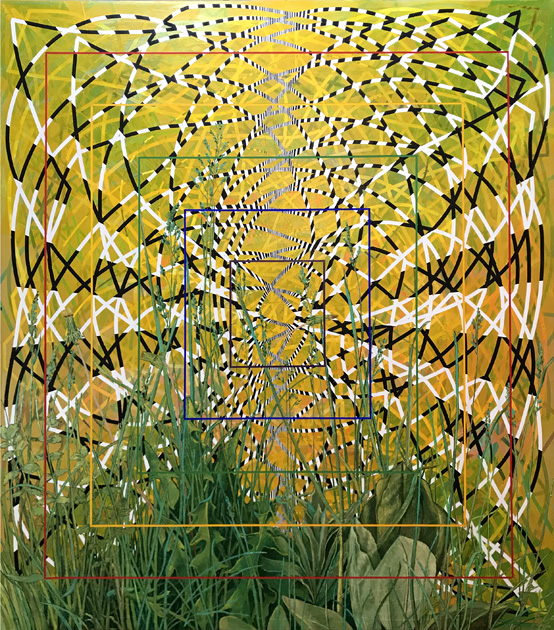
Aurora posits that Being itself is ecstatic - with the sun as the animating energy that activates everything in our orbit.
The sun/aurora/dawn is ecstasy and ignites ecstasy. The vegetation (a replication of Albrecht Dürer’s Great Piece of Turf ) represents rapture taking form. This visual quote along with the allusions to Bridget Riley and Frank Stella are intended to indicate an equivalency in terms of operation and nurturance between the ecosystems of Nature and Art.
Similar to the fleeting luminous forms of the Aurora Borealis, the process of creating the painting generated a sequence of transitory painterly referents. In addition to the Stella-inspired lines mapping the proportions of the canvas and the black and white burst evoking Riley’s Op Art paintings, there is a glimpse of Willem de Kooning’s Rosy-Fingered Dawn at Louse Point and an evocation of Alma Thomas’ radiant circle paintings that persist as pentimenti phantoms.
Other associations were not the result of strategy but rather the unforeseen efflorescence of enthusiasms. Notably, Aurora seems in dialogue with The Rose by Jay DeFeo – a work never far from my thinking and heart.
Also, lately I’ve been listening to Daniel Johnston’s astonishing “True Love Will Find You In The End” (my favorite version is his session at the KCRW studios featuring Lucius.
Speaking of Love, he asks:
“But how can it recognize you
Unless you step out into the light?"
This leads to the moment where Johnston enacts the meaning of the song by making a gift of his vulnerability: in a touching DIY audio effect he crafts his own reverb, intently repeating “the light” a second time so that it initiates an enduring echo in the mind.
In doing so Johnston welcomes into being a photon shower that washes over the listener. This succinct incantation of “the light, the light” resonates in the vernacular of one’s tender inner voice - the whisper within that assures and counsels kindness.
As Alma Thomas, whose work also demonstrates the alchemy of empathy, describes it: “Color is life, and light is the mother of color.”
Details and process:
The Blobsquatches were featured in Capturing the Aura of the Already Said at Cleveland's Zygote Press in the Spring of 2019. The show also presented work by Deborah Carruthers, Gabriel Deerman and Margaret Hart - who curated the exhibit.
Excerpt from the gallery statement:
Mark Roth’s paintings find inspiration in the cryptozoological artifact of blobsquatches – a blobsquatch being the indeterminate blob in a photograph that a keen-eyed observer ascertains is a visual capture of Sasquatch. Generally they take the form of forest views with a circle drawing one’s attention to the purported creature. Roth contends the resilience of Bigfoot speaks to the persistent yearning to see primeval nature staring back at us in a form analogous to our own. In a blobsquatch the circling line is the essential component for it represents the culmination of careful scrutiny and an urgency to share the benefits of passionate looking. In these works the artist has made it his quest to locate evidence of Sasquatch in the paintings of the Metropolitan Museum of Art. The encircling line repeats so that the composition assumes a target shape, utilizing the notion that the bullseye represents an apogee of yearning – in this case to strike a connection with primordial painters in the wilderness of art and its making.
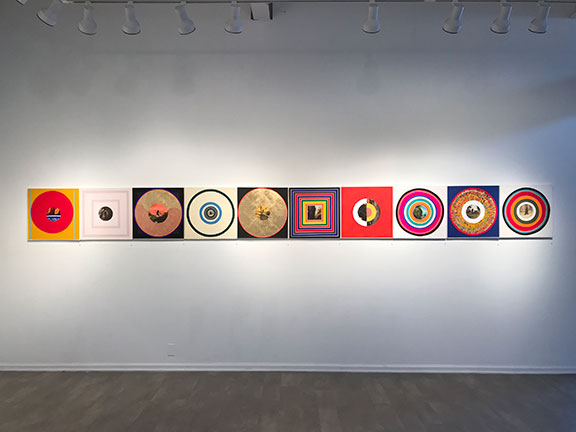
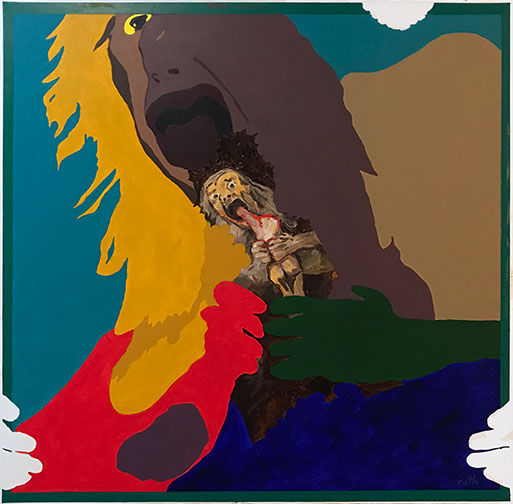
Featured in Tactical Stream #5: "Free" - an exhibit at TBG that considers the externalized, concealed costs supporting unsustainable resource extraction and privilege.
The Opening is Monday July 1, 7-9 pm. The exhibit runs through July 7 at TBG, 616 East 9th St. NYC.
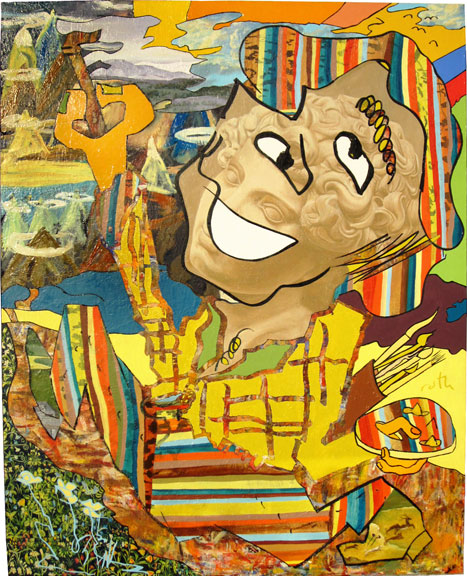
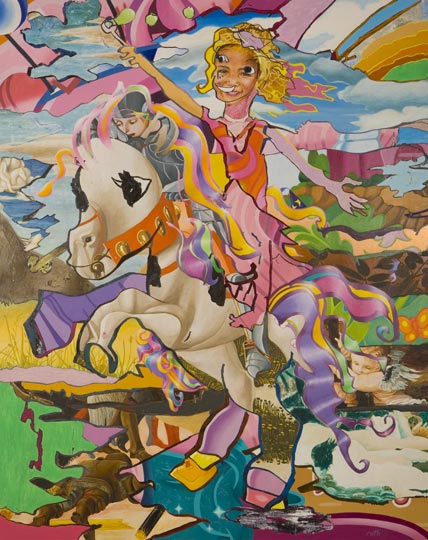
When she was little, my niece poured all her creativity into playing with the My Little Pony dolls. She play-acted the issues and dreams of her world and her understanding of it through them.
These ponies fulfilled the role of art in her life – as they have for at least a generation of young girls. The My Little Pony vehicle communicates so effectively that we fail to recognize it as talismanic. In this way the My Little Pony product-line represents art as it is actually consumed in our era in the same way that, say, a Titian image was unquestioningly, vitally relevant during the Italian Renaissance.
Details:
My niece is unhesitatingly loving, like most children. Once, at age four, she stared wistfully out the window lamenting from her car seat: “I wish there was no pollution.” She hassles her parents for drinking coffee because she learned the rainforest is being cut down to make way for coffee plantations.
All the while, she is lavishing her creative energy upon the My Little Pony world. It is the incubator of her imagination – the arena for constructing a strategy as to how she is going to take action in the larger world, correct its ills and express herself. Her free play rallies a charge into the future just like Joan of Arc leading her army to victory.
This process in which she is engaged – rejecting the world’s despoliation and dreaming of a better, more just, more sensible one – seems the very thing required to save us from ourselves. This painting pays tribute to Innocence as Power.
Process Video:
Selected Preparatory Studies:
Managing the potentially disabling demands of focus and invention that confront every artist who stands before a boundless canvas is key. It’s been my experience that there is a deep desire on the part of the painter - maybe even a necessity - to arrive at some strategic armature or limiting structure within which to act. After all, as Georges Braque said of the sustained inspiration intrinsic to the demands of Fauvism, “You can’t remain forever in a state of paroxysm.”
Many of the liberating restrictions painters have come upon are formal - think Agnes Martin. During this Grand Canyon commission, the resolution of Burro Train delivered a formal armature. But the unspoken collaboration with the client who commissioned the project awoke me to a liberating restriction of another sort: service.
During the course of painting the first Grand Canyon canvas, I registered each moment of acute delight on the part of the client and realized this client was consistent and yet loved having preconceptions eclipsed.
Whether to the painting, a client or the ground beneath our feet, service proves to be self-serving.
Thus, this service to another’s vision laid the foundational “liberating restriction” to a new process and a second canvas in the commission, Canyon Ascent. This phantom restriction most tangibly manifests in an enhanced naturalistic depiction of depth. Maintaining its predecessor's assertive frontality in the advancing picture plane, Canyon Ascent incorporates the client’s desired depiction of depth. (So, its completed surface operates like a subtler version of the telescoping dolly zoom famously used by Hitchcock.)
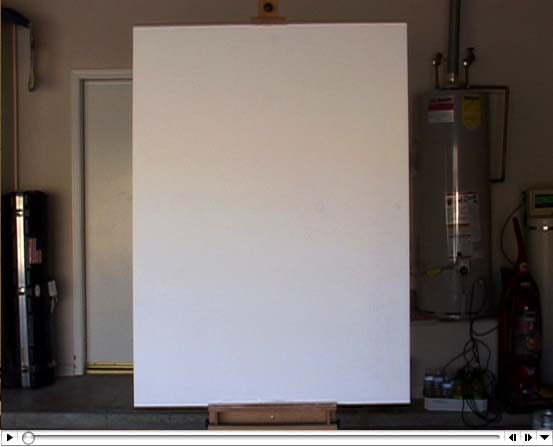
To see the process, click the image above for the hi-res QT movie (1 min., 7.3Mb) or try the YouTube version.
When I first began this assignment - painting an “abstract” Grand Canyon - my initial foothold was the realization that I didn’t have to conceive or execute a vision so much as embody processes congruent to those which formed the Canyon, itself. Geomimicry as painting strategy: The accumulation of sediment (or paint) and the process of erosion that resurfaces that accumulation reveals its unique logic and corresponding beauty.
This created a particularly satisfying development of illusionistic depth and naturalistic proportions. In the same way that the Canyon represents a cleaving through geologic history, Canyon Ascent embodies a scraping through layers of art history.
Its fidelity to the abstractions of geomimicry and service make this painting read as representational. This resolution afforded me the rare experience of physically unearthing the academically observed substratum that undergirds America’s Abstract Expressionists: The Romantic Hudson River School painters - Cole, Kensett, Gifford, Bierstadt, Church.
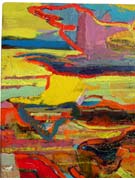 |
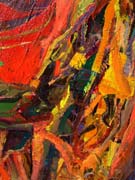 |
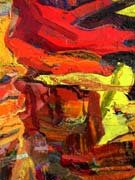 |
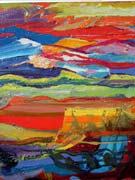 |
 |
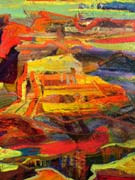 |
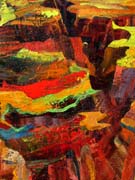 |
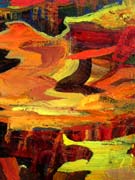 |
For a "Special Features" insight into this post click for further commentary.
Being incomprehensible to quotidian existence, the Grand Canyon presents an uncommonly great subject for a painting.
This sentiment did not originate with me - recently, it was re-introduced by a client who, enthused by the emergence of landscape in my Mountain Paintings, was curious to see what would be my abstract response to the Grand Canyon.
So began a two month encampment in Arizona where, under the sun, in unspoken collaboration with my client, I was an object of bemusement and intrigue to a gated-community in Scottsdale. In this atmosphere, I got my mind around the project while developing a vocabulary at breakneck speed.
Amazingly - and, perhaps, fortuitously - I’d embarked on the project with no previous firsthand experience of the Grand Canyon. Sedona - which one experiences as a landscape of protuberances, not a canyon - was the furthest north I’d ever travelled in Arizona. (Note: you can see the “before and after” transformation in the painting’s video where the canvas shifts from the Sonoran Valley of the Sun to take on the depth and breadth so aptly noted in the name, Grand Canyon).
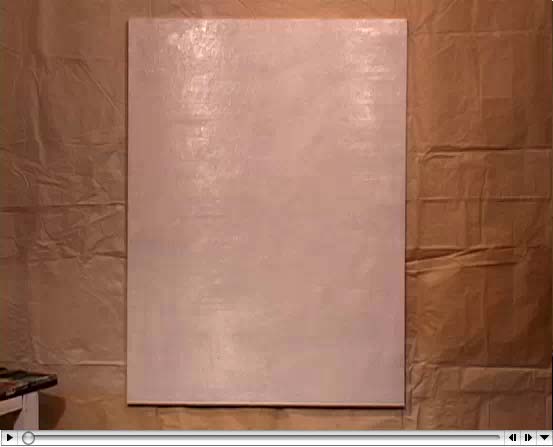
To see the process: Click the image above for the hi-res QT movie (1 min., 6.6Mb) or try the YouTube version.
Upon arriving at the Canyon, I was guided to the rim with my eyes shut. My hosts positioned me so that my first glimpse would be unobstructed and immediate. Opening my eyes, my first impression was that the scene appeared flat - like a cinematic backdrop. The sense of scale was unintelligible. The shadows in the distance read as positive shapes - having more solidity than the rock. The drama was that of alternating intervals of sun and shadow dappling across the unfathomable expanse.
From the rim, especially in the bleaching midday sun, this grand panorama registers as an uncannily and solely retinal experience; Walking into it does not feel like an option.
All this, I wanted in the painting.
Plainly, though, I was going to have to get physically into the landscape. The South Kaibab Trail obliged. Upon going over the rim, the Canyon instantly becomes a participatory event - hiking, an act of sculpting - each step down raises the horizon up. This I wanted to get into the painting, too.
It is a fascinating irony that two-dimensional, pictorial depiction dictates a correspondence between moving down into the canyon and moving up the canvas. This became an experiential dynamic of the painting. As a point of reference, I remembered the Met’s Joachim Patinir painting, The Penitence of Saint Jerome, whose gallery wall label reads, in part:
“The true subject of the picture, however, is Patinir's splendid panoramic landscape, which the viewer is encouraged to travel through visually in the manner of a pilgrimage.”
Hence, the incorporation of the burro train whose members are (pun intended) burrowing their way ever deeper into the canyon while correspondingly ascending the canvas in a pilgrimage of step-by-step transcendence that's all in a day's work.
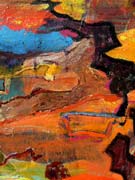 |
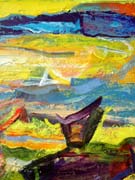 |
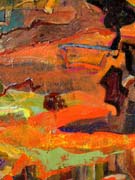 |
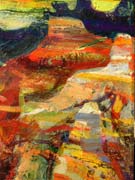 |
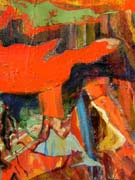 |
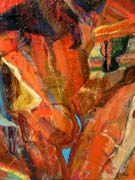 |
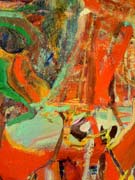 |
 |
Burro Train is still available for purchase. Why, you might ask, if it was a commission? Well, the process and subject was so engaging that I immediately painted a follow-up, Canyon Ascent, which the client chose after considerable debate. I’ll post this second painting next.
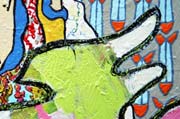 |
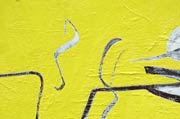 |
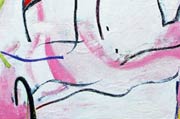 |
 |
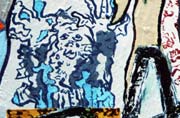 |
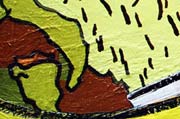 |
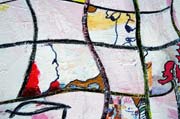 |
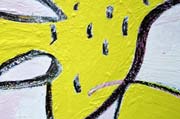 |
 |
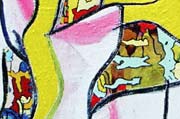 |
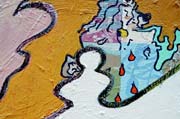 |
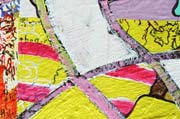 |
And so, with this post of details, “Goya Moment” week concludes at TINSQUO.
This painting is conceived to function across scales, implicitly positing that there is no privileged point of view other than the one you’re currently experiencing.
In the artblog entrance to the painter’s life, consider this post a virtual hoisting of a mug at a cyber Cedar Tavern. Thanks for lingering with me in this pause before attention turns to the next canvas.
For a recap, see the prior entry of states and the time-lapse DV of the painting’s creation (QT 8.5).
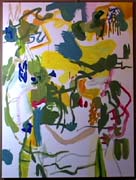 |
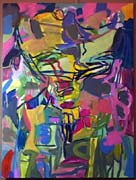 |
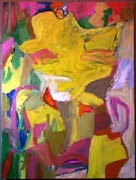 |
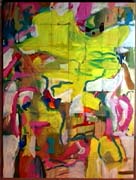 |
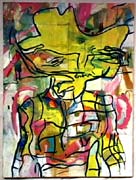 |
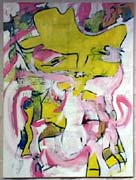 |
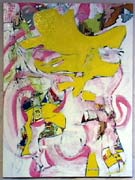 |
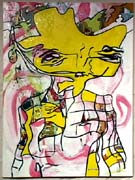 |
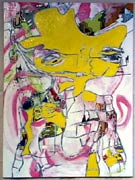 |
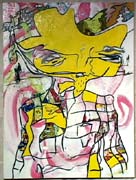 |
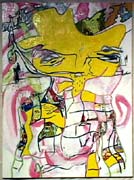 |
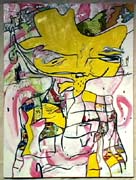 |
Here's a selection of some of the key states of "Goya Moment." For a while, I felt confident the painting was finished as it appears in the tenth state, above. But that was wishful thinking.
There are no shortcuts. The painting decides when it's done.
For all the intervening phases of development, see the time-lapse DV (QT 8.5 MB).
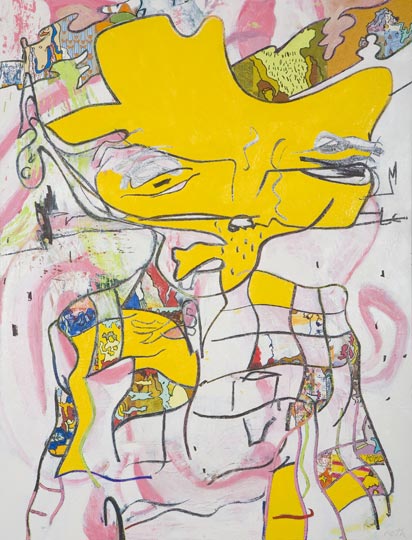
This painting is the whole reason I dreamed up TINSQUO.com. A culmination of months of studio work, "Goya Moment" is a fulfillment of the vision behind this site. It brings the longterm processes at work within the artblog to a momentary resolution.
For elucidation on TINSQUO processes, see Narrative on the "about" page.
Details:
Process Video:
States: